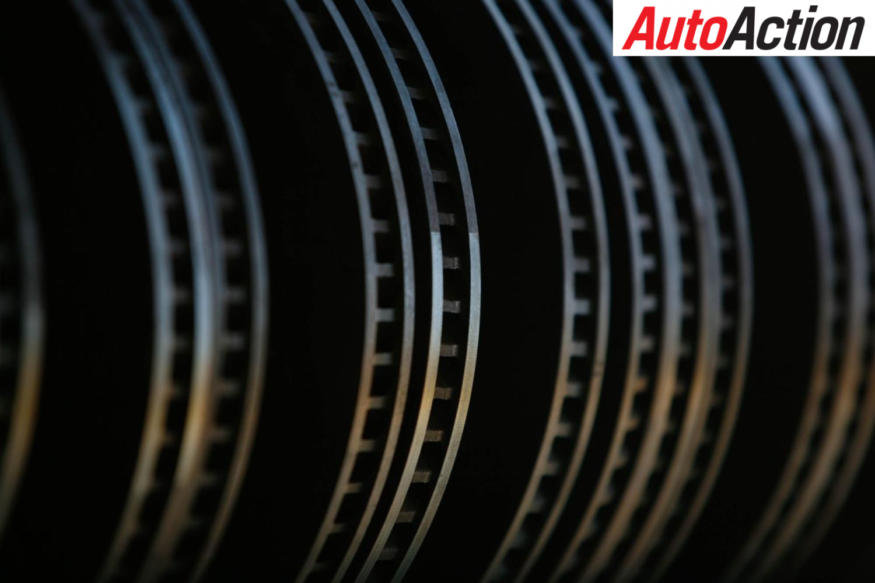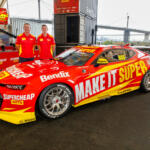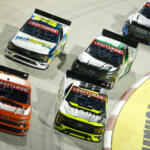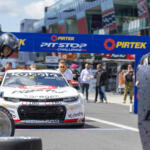REVEALED: SUPERCARS BRAKE CHANGE


Supercars to use beefed-up brake rotors – Photo: LAT
BEEFED-UP BRAKE rotors will be adopted for the upcoming Supercars endurance races in a change aimed at eliminating the risk of exploding discs at Bathurst.
By MARK FOGARTY
Following a spate of failures last year, brakes supplier AP Racing has developed more durable rotors designed to withstand rapid temperature changes.
Along with the update, a change of brake discs during the Bathurst 1000 will now be compulsory to further limit the chance of rotors cracking or disintegrating.
This year’s race will be the first time brake replacements, once commonplace in the 1000 km classic, are mandated.
The new brake discs are due to be introduced at The Bend SuperSprint next week to allow teams to adapt to the strengthened stoppers before the Sandown 500 mid-next month and the Bathurst 1000 in early October.
The upgraded rotors were initially scheduled to be optional for The Bend before becoming mandatory from Sandown onwards.
But amid concerns that teams could gain an advantage by not switching to the new brakes, AUTO ACTION understands that a motion has gone to the Supercars Commission to make the change compulsory at The Bend.
It is expected that the changeover will be enforced from the new South Australian event to provide a level playing field and give all the teams more time to get familiarised with the braking characteristics of the improved rotors before the enduros.
Supercars already plans to monitor the performance of the replacement discs at Sandown and in all practice and qualifying sessions at Mount Panorama.
The change comes after several instances of cracked and exploding brake rotors in recent years, especially in circumstances involving rapid slowing from high to low speeds that produce a big temperature variation.
The potential weakness was highlighted at last year’s Bathurst 1000, when increased speeds and braking loads caused failures.
It was particularly acute at Mount Panorama because of the extreme brake temperature differences from the end of Conrod Straight through The Chase to Murray’s and then Hell Corners, going from very cool to tremendously hot.
While Supercars confirmed the introduction of new brake rotors to address the specific issue at Bathurst, no details of the changes or technical specifications were provided.
But AA has learned that Brembo-owned AP Racing’s redesigned control steel discs are marginally wider with larger external cooling vanes, accompanied by slightly modified calipers.
The mandated size of the existing AP rotors, which have been used since the switch to the New Generation (formerly Car Of the Future) technical rules in 2013, are 395 mm diameter at the front and 355 mm at the rear. They use six-piston calipers at the front and four-pots at the rear.
No figures for the width of the ventilated disc brakes are readily available.
According to Supercars sporting and technical director David Stuart, the upgraded rotors are primarily to cope with the unusual demands at Mount Panorama.
“It’s a situation unique to Bathurst with three extremely high temperature braking loads in quick succession at the Chase, Murray’s Corner and Hell Corner,” Stuart told AA. “With the cars now much faster and more powerful than they have ever been, by some four to five seconds, the overall loads have increased significantly.
“AP has done a huge amount of testing and presented their proposed disc for the endurance events. We will monitor their performance at Sandown and across the six practice sessions before the Sunday race at Bathurst.
“The teams have had plenty of notice to prepare in time.”
AA has been told by informed sources that it took UK-based AP Racing two years to replicate the fracture-inducing rapid temperature change on its brake dynamometer.
Supercars emphasised that the teams were advised of the impending brake rotor alteration “some time ago and are prepared”.
It was also stressed that since the switch to AP brakes in ’13, teams have not had to change “the superior” rotors during the Bathurst 1000 due to wear or fatigue.
“The fact rotor changes have been common place over the years at Bathurst shows just how strong the AP discs have been for teams to not change them across the course of 1000 km,” Stuart noted. “Until the last few years since the introduction of the Car Of The Future, teams regularly changed rotors mid-race.
“At SBR (where he was team manager until joining Supercars), we would do at least two disc changes at Bathurst.
“You can change a set of rotors within a fuel stop, so it is not a burden from a racing perspective. It is up to the team’s discretion if and when they want to make a change.”
However, in a follow-up to AA’s story, the official web site reported that the Supercars Commission had decided on the further precaution of making a change of brake discs during the Bathurst 1000 mandatory.
For more of the latest Supercars news, pick up the latest issue of Auto Action, on sale now. Also make sure you follow us on social media Facebook, Twitter, Instagram or our weekly email newsletter for all the latest updates between issues.





